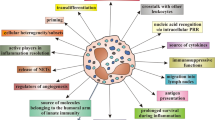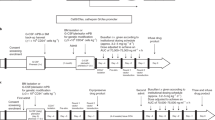Abstract
Leukocyte adhesion deficiency-1 (LAD-1), a genetic immunodeficiency disease characterized by life-threatening bacterial infections, results from the defective adherence and migration of leukocytes due to mutations in the leukocyte integrin CD18 molecule. Canine LAD (CLAD) represents the canine homologue of the severe phenotype of LAD-1 in children. In previous studies we demonstrated that non-myeloablative stem cell transplantation from matched littermates resulted in mixed donor–host chimerism and reversal of the disease phenotype in CLAD. In this study, we describe two CLAD dogs with less than 2% donor leukocyte chimerism following non-myeloablative transplant. Both dogs are alive more than 24 months after transplant with an attenuated CLAD phenotype resembling the moderate deficiency phenotype of LAD. The improvement in the CLAD phenotype with very low levels of donor CD18+ leukocytes correlated with the preferential egress of the CD18+ neutrophils into extravascular sites. The clinical response with very low levels of donor CD18+ leukocytes in CLAD supports using this model for testing gene therapy strategies since the low levels of gene-corrected hematopoietic cells expected with hematopoietic gene therapy would likely have a therapeutic effect in CLAD.
This is a preview of subscription content, access via your institution
Access options
Subscribe to this journal
Receive 12 print issues and online access
$259.00 per year
only $21.58 per issue
Buy this article
- Purchase on Springer Link
- Instant access to full article PDF
Prices may be subject to local taxes which are calculated during checkout





Similar content being viewed by others
References
Abramson JS, Mills EL, Sawyer MK, Regelmann WR, Nelson JD, Quie PG . Recurrent infections and delayed separation of the umbilical cord in an infant with abnormal phagocytic cell locomotion and oxidative response during particle phagocytosis. J Pediatr 1981; 99: 887–894.
Anderson DC, Schmalstieg FC, Finegold MJ, Hughes BJ, Rothlein R, Miller LJ et al. The severe and moderate phenotypes of heritable Mac-1, LFA-1 deficiency: their quantitative definition and relation to leukocyte dysfunction and clinical features. J Infect Dis 1985; 152: 668–689.
Kishimoto TK, Hollander N, Roberts TM, Anderson DC, Springer TA . Heterogenous mutations in the b subunit common to the LFA-1, Mac-1, and p150,95 glycoproteins cause leukocyte adhesion deficiency. Cell 1987; 50: 193–202.
Bowen TJ, Ochs HD, Altman LC, Price TH, Van Epps DE, Brautigan DL et al. Severe recurrent bacterial infections associated with defective adherence and chemotaxis in two patients with neutrophils deficient in a cell-associated glycoprotein. J Pediatr 1982; 101: 932–940.
Fischer A, Lisowska-Grospierre B, Anderson DC, Springer TA . Leukocyte adhesion deficiency: molecular basis and functional consequences. Immunodefic Rev 1988; 1: 39–54.
Anderson DC, Springer TA . Leukocyte adhesion deficiency: an inherited defect in the Mac-1, LFA-1, and p150,95 glycoproteins. Annu Rev Med 1987; 38: 175–194.
Fischer A, Trung PH, Descamps-Latscha B, Lisowska-Grospierre B, Gerota I, Perez N et al. Bone marrow transplantation for inborn error of phagocytic cells associated with defective adherence, chemotaxis, and oxidative response during opsonized particle phagocytosis. Lancet 1983; 1: 473–476.
Le Diest F, Blanche S, Keable H, Gaud C, Pham H, Descamp-Latscha B et al. Successful HLA nonidentical bone marrow transplantation in three patients with the leukocyte adhesion deficiency. Blood 1989; 74: 512–516.
Thomas C, Le Deist F, Cavazzana-Calvo M, Benkerrou M, Haddad E, Blanche S et al. Results of allogeneic bone marrow transplantation in patients with leukocyte adhesion deficiency. Blood 1995; 86: 1629–1635.
Renshaw HW, Chatburn C, Bryan GM, Bartsch RC, Davis WC . Canine granulocytopathy syndrome: neutrophil dysfunction in a dog with recurrent infections. J Am Vet Med Assoc 1975; 166: 443–447.
Renshaw HW, Davis WC . Canine granulocytopathy syndrome: an inherited disorder of leukocyte function. Am J Pathol 1979; 95: 731–744.
Creevy KE, Bauer Jr TR, Tuschong LM, Embree LJ, Colenda L, Cogan K et al. Canine leukocyte adhesion deficiency (CLAD) colony for investigation of novel hematopoietic therapies. Vet Immunol Immunopathol 2003; 94: 11–22.
Trowald-Wigh G, Ekman S, Hansson K, Hedhammar Å, Hård af Segerstad C . Clinical, radiological and pathological features of 12 Irish setters with canine leucocyte adhesion deficiency. J Small Anim Pract 2000; 41: 211–217.
Kijas JMH, Bauer Jr TR, Gäfvert S, Marklund S, Trowald-Wigh G, Johannisson A et al. A missense mutation in the b-2 integrin gene (ITGB2) causes canine leukocyte adhesion deficiency. Genomics 1999; 61: 101–107.
Bauer Jr TR, Gu YC, Tuschong LM, Burkholder T, Bacher JD, Starost MF et al. Nonmyeloablative hematopoietic stem cell transplantation corrects the disease phenotype in the canine model of leukocyte adhesion deficiency. Exp Hematol 2005; 33: 706–712.
Bauer Jr TR, Creevy KE, Gu YC, Tuschong LM, Donahue RE, Metzger ME et al. Very low levels of donor CD18+ neutrophils following allogeneic hematopoietic stem cell transplantation reverse the disease phenotype in canine leukocyte adhesion deficiency. Blood 2004; 103: 3582–3589.
Wagner JL, Burnett RC, DeRose SA, Francisco LV, Storb R, Ostrander EA . Histocompatibility testing of dog families with highly polymorphic microsatellite markers. Transplantation 1996; 62: 876–877.
Donahue RE, Kirby MR, Metzger ME, Agricola BA, Sellers SE, Cullis HM . Peripheral blood CD34+ cells differ from bone marrow CD34+ cells in Thy-1 expression and cell cycle status in nonhuman primates mobilized or not mobilized with granulocyte colony-stimulating factor and/or stem cell factor. Blood 1996; 87: 1644–1653.
Creevy KE, Bauer Jr TR, Tuschong LM, Embree LJ, Silverstone AM, Bacher JD et al. Mixed chimeric hematopoietic stem cell transplant reverses the disease phenotype in canine leukocyte adhesion deficiency. Vet Immunol Immunopathol 2003; 95: 113–121.
Jacobsen CN, Aasted B, Broe MK, Petersen JL . Reactivities of 20 anti-human monoclonal antibodies with leucocytes from ten different animal species. Vet Immunol Immunopathol 1993; 39: 461–466.
Breen M, Jouquand S, Renier C, Mellersh CS, Hitte C, Holmes NG et al. Chromosome-specific single-locus FISH probes allow anchorage of an 1800-marker integrated radiation-hybrid/linkage map of the domestic dog genome to all chromosomes. Genome Res 2001; 11: 1784–1795.
Storb R, Yu C, Zaucha JM, Deeg HJ, Georges G, Kiem HP et al. Stable mixed hematopoietic chimerism in dogs given donor antigen, CTLA4Ig, and 100 cGy total body irradiation before and pharmacologic immunosuppression after marrow transplant. Blood 1999; 94: 2523–2529.
Trowald-Wigh G, Håkansson L, Johannisson A, Norrgren L, Hård af Segerstad C . Leucocyte adhesion protein deficiency in Irish setter dogs. Vet Immunol Immunopathol 1992; 32: 261–280.
Storb R, Yu C, Wagner JL, Deeg HJ, Nash RA, Kiem HP et al. Stable mixed hematopoietic chimerism in DLA-identical littermate dogs given sublethal total body irradiation before and pharmacological immunosuppression after marrow transplantation. Blood 1997; 89: 3048–3054.
Sokolic RA, Bauer Jr TR, Gu YC, Hai M, Tuschong LM, Burkholder T et al. Nonmyeloablative conditioning with busulfan before matched littermate bone marrow transplantation results in reversal of the disease phenotype in canine leukocyte adhesion deficiency. Biol Blood Marrow Transplant 2005; 11: 755–763.
Wagner JL, Burnett RC, Storb R . Organization of the canine major histocompatibility complex: current perspectives. J Hered 1999; 90: 35–38.
Raeste AM . The differential count of oral leukocytes. Scand J Dent Res 1972; 80: 63–67.
Borregaard N, Cowland JB . Granules of the human neutrophilic polymorphonuclear leukocyte. Blood 1997; 89: 3503–3521.
Faurschou M, Borregaard N . Neutrophil granules and secretory vesicles in inflammation. Microbes Infect 2003; 5: 1317–1327.
Lindbom L, Werr J . Integrin-dependent neutrophil migration in extravascular tissue. Semin Immunol 2002; 14: 115–121.
Kerksiek KM, Pamer EG . T cell responses to bacterial infection. Curr Opin Immunol 1999; 11: 400–405.
Wong P, Pamer EG . CD8 T cell responses to infectious pathogens. Annu Rev Immunol 2003; 21: 29–70.
Acknowledgements
This research was supported by the Intramural Research Program of the National Institutes of Health, National Cancer Institute, Center for Cancer Research.
Author information
Authors and Affiliations
Corresponding author
Rights and permissions
About this article
Cite this article
Gu, YC., Bauer, T., Sokolic, R. et al. Conversion of the severe to the moderate disease phenotype with donor leukocyte microchimerism in canine leukocyte adhesion deficiency. Bone Marrow Transplant 37, 607–614 (2006). https://doi.org/10.1038/sj.bmt.1705291
Received:
Revised:
Accepted:
Published:
Issue Date:
DOI: https://doi.org/10.1038/sj.bmt.1705291
Keywords
This article is cited by
-
Long-Term Follow-up of Foamy Viral Vector-Mediated Gene Therapy for Canine Leukocyte Adhesion Deficiency
Molecular Therapy (2013)
-
Reduced-intensity conditioning hematopoietic SCT for pediatric patients with LAD-1: clinical efficacy and importance of chimerism
Bone Marrow Transplantation (2012)
-
Gene Therapy of Canine Leukocyte Adhesion Deficiency Using Lentiviral Vectors With Human CD11b and CD18 Promoters Driving Canine CD18 Expression
Molecular Therapy (2011)
-
Lentiviral vectors incorporating a human elongation factor 1α promoter for the treatment of canine leukocyte adhesion deficiency
Gene Therapy (2010)
-
Successful treatment of canine leukocyte adhesion deficiency by foamy virus vectors
Nature Medicine (2008)



